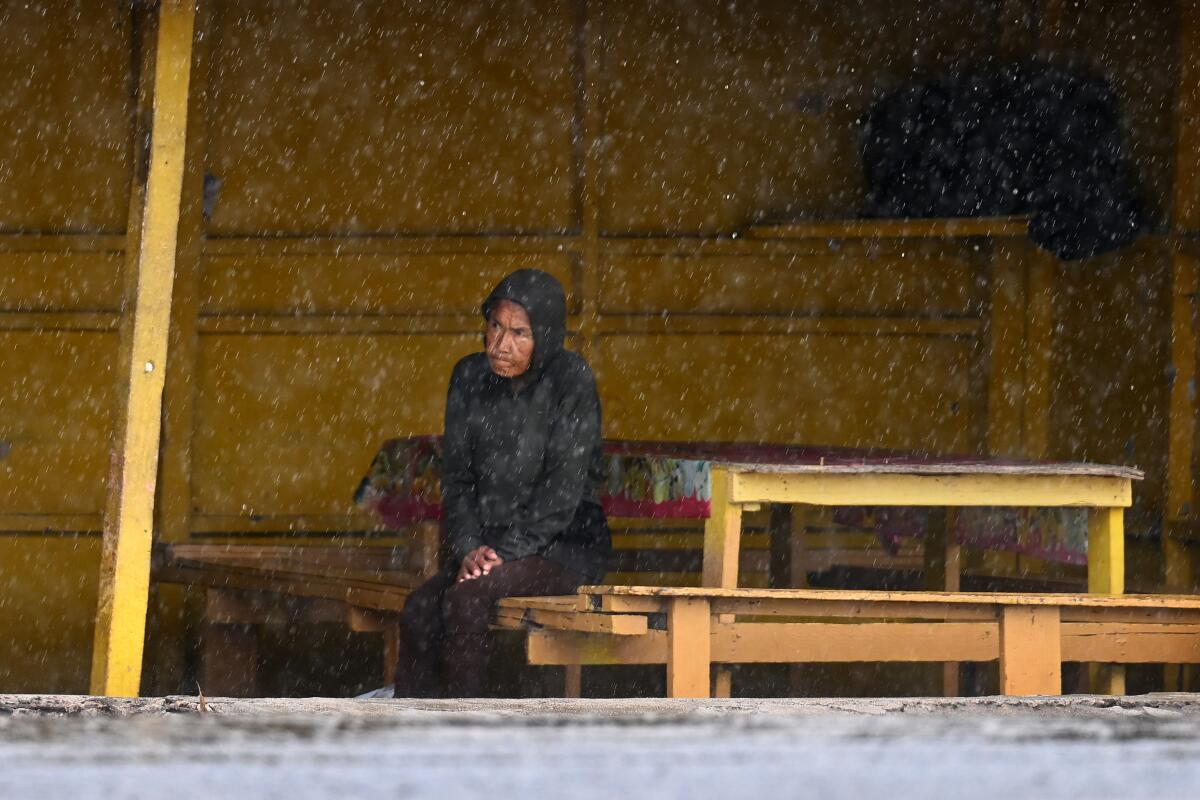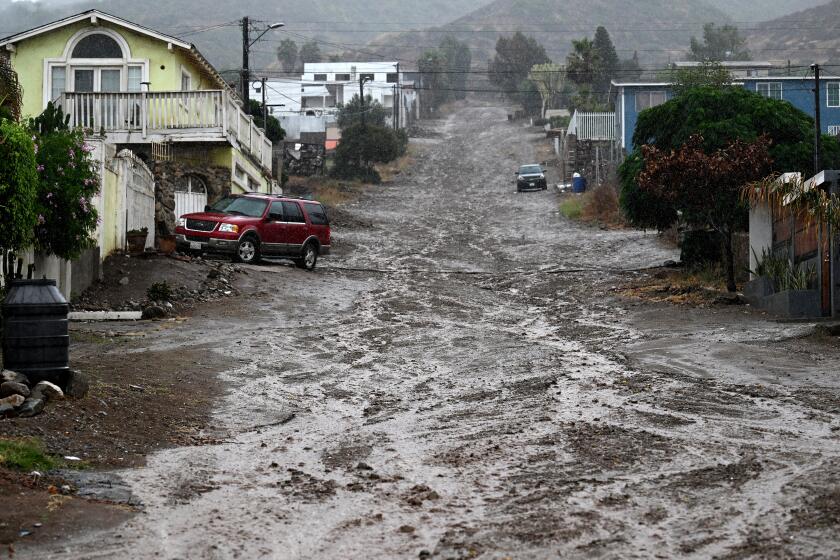‘It ain’t over yet’: Hilary brings heavy rain, threat of overnight flooding

- Share via
Tropical Storm Hilary, after barreling through Baja California, struck Southern California on Sunday, causing widespread, often heavy rain, flooding, downed trees, road closures and power outages.
At around 8:15 p.m., the center of the storm had jogged west and was circulating directly over Dodger Stadium, according to Daniel Swain, a UCLA climate scientist.
As the storm stalled off Los Angeles and Ventura counties, and its southern edge moved north, new flash flood advisories popped up throughout southern and southeastern California, while the National Hurricane Center reported maximum sustained winds of 45 mph near the coast of Southern California.
“I think that we may see some more significant flooding redeveloping overnight in the southeastern desert,” Swain said, “and so really, it ain’t over yet.”
On Sunday afternoon, multiple school districts, including Los Angeles Unified, announced that classes were canceled for Monday.
The National Weather Service warned of life-threatening flooding amid heavy rain in western L.A. County and eastern Ventura County, generally west of Point Dume in Malibu and east of Point Mugu. Areas affected included Camarillo and Newbury Park.
Earlier in the afternoon, with Southern California focused on storm preparations, a magnitude 5.1 earthquake rattled the Ojai area. It was another reminder of Mother Nature’s unpredictable temperament for a region already on edge.
Daily rainfall records were shattered in downtown Los Angeles, at Long Beach Airport and at Los Angeles International Airport. Meanwhile, Santa Maria Airport experienced a record high temperature of 85 degrees, beating the previous 82 degrees in 2007.
At an afternoon news conference, Los Angeles Mayor Karen Bass warned that “the worst of the rains is potentially left to come.” Flanked by Gov. Gavin Newsom, city officials and emergency responders, she noted that winds were likely to pick up during the evening and night hours.
“Fortunately, we have had no reports of any injuries or significant damage at this time,” L.A. Fire Chief Kristin Crowley said at the news conference, but there were a few incidents that had been reported: One person had been rescued from a flooded car, wires were down throughout the city, two debris flow incidents had occurred in the Sherman Oaks area, and a large tree had toppled over in Westwood.
L.A. Fire Department spokesperson David Ortiz said on Sunday evening that one person had “self-rescued” from the L.A. River near the Vernon and Huntington Park area. Ortiz said the person had traveled a “remarkable distance” from Lincoln Heights in an already quickly moving and powerful river.
“It’s miraculous that this person survived,” he said.
As of Sunday evening, the greatest amount of rain had fallen in eastern Los Angeles County. The National Weather Service reported two-day rainfall totals of 4.32 inches in Palmdale, 4.28 inches in Saugus and 4.21 in Valyermo. Along the coast and in the San Fernando and San Gabriel valleys, totals were significant but smaller: 1.89 inches in Beverly Hills, 2.02 inches in Northridge and 1.81 at Eagle Rock Reservoir.
Rainfall totals continued to rise into the late evening as the precipitation continued to fall. Meanwhile, at 9 p.m., roughly 50,000 customers were without power in Los Angeles County.
“It’s gonna be a long night,” said Swain, who said he was getting reports of “very destructive debris flows, and I suspect we’ll hear a lot more in the morning.”
Bristlecone trail in Nevada, west of Las Vegas, picked up six inches of rain within a 24-hour period, which broke the all-time record for any tropical cyclone or related rainfall in the state.
Significant rain will persist through Monday morning, forecasters said. A number of roads throughout the deserts and southeastern California suffered flooding Sunday and were closed, including stretches along Highway 38, in the San Bernardino Mountains.
Forecasters called the rainfall amounts historic, and expressed particular concern about San Bernardino and Inyo counties. Death Valley and Morongo Basin were expected to see the most significant flooding Sunday night into Monday morning.
Swain said that, with climate change, extreme precipitation events like Hilary would become more common as the planet warmed.
“We know, in a warming climate,” he said, “the atmosphere’s capacity to hold water vapor increases exponentially.”
Along the Baja Peninsula, where Hilary had plowed through earlier in the day, at least one person was reported drowned in the Mexican town of Santa Rosalia when a vehicle was swept away in an overflowing stream. Rescue workers saved four other people, said Edith Aguilar Villavicencio, the mayor of Mulege township.
On Sunday afternoon, the Los Angeles Unified School District announced that schools would be closed Monday to ensure that campuses could be inspected after Hilary passed through and to avoid potential morning commute hazards. The uncertainty brought by the storm led to wide-ranging — but not universal — public school closures for Monday across much of the Southern California region, including Pasadena, Palm Springs and San Diego.
President Biden weighed in Sunday evening, noting that he had deployed the Federal Emergency Management Agency and the Coast Guard so that “federal personnel and supplies that can be surged to impacted communities” and in place should there be a need “for rapid response and search-and-rescue efforts.”
“My Administration stands ready to provide additional assistance as requested. I urge people to take this storm seriously, and listen to state and local officials,” he said in a statement.
For at least the last 165 years, three conditions have kept California hurricane-free, experts say. So what’s changed to make Hurricane Hilary possible?
Across Southern California early Sunday, residents in flood-prone areas gathered to fill sandbags as shoppers emptied shelves of batteries, water and other goods. Beaches in San Diego, Orange and Los Angeles counties were ordered closed.
By noon, there were some road closures in Southern California, including a section of Pacific Coast Highway in Huntington Beach and truck lane connectors from the 5 Freeway to Highway 14. Major theme parks also closed. Knott’s Berry Farm and Six Flags Magic Mountain closed, and Disneyland announced it would shut its doors early.
And although San Diego had largely dodged the storm earlier Sunday, by late evening, the back side of the storm was lashing the region, dousing it in rain.
Farther east, reports of flooding poured in, including inside the Eisenhower Hospital in Rancho Mirage. In the town of Thermal, power went out as heavy rain fell. As the evening wore on, numerous reports of power outages popped up elsewhere in the region. Winds were buffeting trees in the city of Coachella on Sunday evening, and some roads had flooded.
Earlier Sunday, as evacuation warnings remained in places such as Catalina Island and some communities in San Bernardino and Riverside counties, and reports of flood and wind damage piled in, some residents from Southern California to Tijuana — many of whom had never experienced a tropical storm — shrugged off the dangers of the storm.
“My plan is, I’m just gonna stay right here and I’m just gonna work,” said candy seller Johnathan Muñoz, in the Tijuana neighborhood of Aviacion.
In advance of the storm, the Mexican government put 18,000 soldiers on alert. Officials in the flood-prone Tijuana area opened five temporary shelters and reported that families had already begun arriving late Saturday night. Beaches were also closed.
“I’m just praying that nobody gets hurt,” Muñoz said.
But several said they hadn’t taken precautions even as they knew that the poor infrastructure was unlikely to prevent flooding.
“I’m going to be here,” said Julian Castillo, whose family has lived in Tijuana’s middle-class Colonia Castillo neighborhood since the 1990s. Just a block away, deep murky water pooled at the bottom of a hill.
“It always gets flooded. When it rains down there it clogs very easily,” Castillo said. “People here don’t clean up the storm drains before the rain. They do it after something happens.”
Hurricane Hilary is likely to make landfall in Los Angeles as a tropical storm, bringing heavy rains and potential flooding. Here’s what you can do now to prepare, and how to stay safe when the storm arrives.
Over the border in California, San Bernardino County Fire Battalion Chief Mike McClintock said more than 100,000 sandbags had been distributed to residents at fire stations over the last couple of days.
Other county departments are busy clearing out floodways and evacuating homeless people along drainage areas in the region. The county has added more than 50 people to swift-water evacuation and strike teams so they can more quickly respond to emergencies, McClintock said.
“We have an all-hands-on-deck approach to getting things going,” he said. “This tropical storm making landfall is kind of historic in our generation. ... We are not taking that lightly.”
The county has ordered evacuations in mountain areas with serious burn scars from the El Dorado and Apple fires in recent years.
“We’ve seen over this last rainy system immense amount of mudflow and debris flow going downhill in those areas,” McClintock said. “We have been preparing, but better safe than sorry, and we’re asking residents in those areas to heed those warnings.”
Officials urged residents to take the storm seriously and monitor forecast updates and ensure they have multiple methods of receiving warnings, including wireless emergency alerts, weather apps and local TV, radio and news stations. Los Angeles officials said they were ready to evacuate people if need be.
At the Fuente de Agua Viva, a church in Mecca, 50 people gathered for the Sunday 11 a.m. service. The storm had not yet reached the Riverside town, although a light rain fell.
“How many are scared because of the hurricane?” Pedro Miranda, the minister asked, as he held up his arm for a show of hands. Nobody raised theirs.
Miranda had initially planned to hold the service outside, “but the Lord’s plan was for us to be here,” he said, before leading worshipers in a prayer for those in affected areas.
“We’re going to thank God because he is good,” Miranda said. “Our desert needs water.”
Among those attending the service was Olga Granados, who wore a black head covering with green trim. She said she hadn’t seen anything weather-wise to make her worry, just occasional rain.
“We’re calm here,” she said with a smile.
“We got 30 bags and no rain,” a young man complained outside the church, as he recounted to a friend that he’d stocked up on sandbags.
Tijuana officials took to social media to warn people to stay off the roads, seal doors and windows and avoid crossing fast-moving water.
Fears of flooding, landslides and dangerous coastal rip currents prompted Gov. Newsom to declare a state of emergency Saturday evening, and Bass signed a local emergency declaration.
He toured the Emergency Operations Center at San Bernardino County on Sunday.
Among those worrying was Martina Zacarias, a 20-year resident at Oasis Mobile Home Park in Thermal. She and her husband, both farmworkers, last worked on Friday, helping bag dates to protect them from the rain.
As the rain poured down, sending rivulets of water cascading into her driveway, Zacarias said she was anxious about her work hours.
“We’re not going to be able to work until it all dries,” Zacarias said. Lack of work doesn’t mean the bills stop coming. And they have a $675 rent to think about.
“We always need to be working. If we don’t work, we don’t have food.”
On Sunday night, her worry intensified. The power had been knocked out and the wind was raging.
At 6 p.m., she left her trailer and headed to the Galilee Center, which was operating as a shelter in Mecca. She was joined by her mother and two sisters. The rest of her family decided to tough it out in the trailer.
The Associated Press contributed to this report.
More to Read
Sign up for Essential California
The most important California stories and recommendations in your inbox every morning.
You may occasionally receive promotional content from the Los Angeles Times.
























